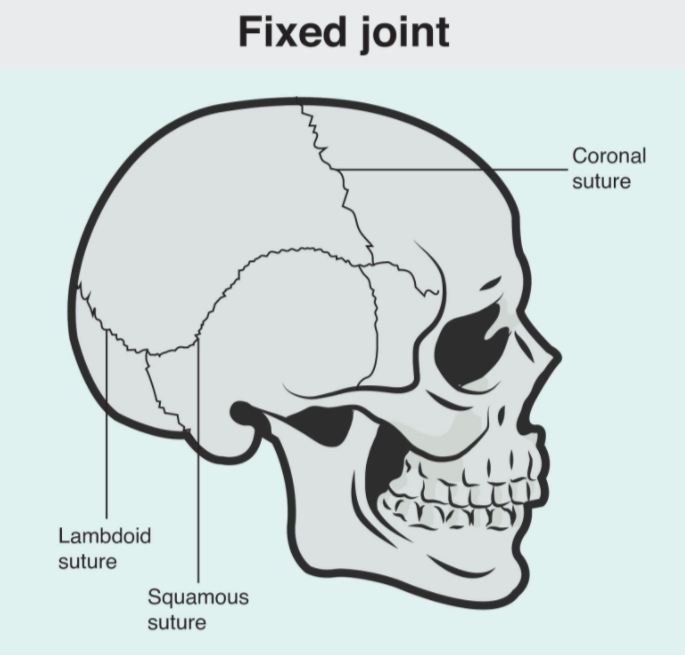
Give an example of a fixed joint.
Answer
570k+ views
Hint: Fixed joints are only located within the skull. This is often also referred to as a specialised joint in adults these joints are little or no movement but in children, it's more mobile.
Complete step by step answer:
Fibrous or fixed joints or Immovable joints: These joints are held together by tough tissue which develops during childhood. Example: Cranium, pri cartilaginous joint in children and cranial sutures in adults.

Additional Information: Bones are joined by fibrous tissue/dense animal tissue, consisting mainly of collagen. The fibrous joints or fixed joints are further divided into three types:
- Sutures which are also known as synostoses are found between bones of the skull. In fetal skulls, the sutures are wide to permit slight movement during birth. They later become rigid (synarthrodial).
- Syndesmoses are joints where two adjacent bones are joined together by a greater amount of animal tissue than in sutures within the sort of interosseous ligaments and membranes. Eg- interosseous radioulnar joint, interosseous tibiofibular joint.
- Gomphoses may be a specialized suture restricted to fixation of teeth in alveolar sockets of the maxilla or mandible. The basis of the tooth is attached to the socket within the alveolus by the periodontal ligament.
Note: Sutures in the skull are:
- The coronal suture: a straight suture that lies across the skull separating the os frontale ahead from the parietal bones behind.
- The sagittal suture: a straight suture that lies in between the 2 parietals within the midline plane, it meets the sutura coronalis anteriorly and the lambdoid posteriorly.
- The lambdoid suture: a really coarse, tortuous, inverted- V like suture whose apex meets the posterior end of the interparietal suture and its diverging two limbs descend within the direction of the mastoid to satisfy the occipitotemporal suture, this suture separates the occipital from the parietal bones and frequently contains sutural bones.
- Metopic suture: usually obliterated but may continue 8% of adults, it's a vertical suture that separates the os frontale into two bones.
Complete step by step answer:
Fibrous or fixed joints or Immovable joints: These joints are held together by tough tissue which develops during childhood. Example: Cranium, pri cartilaginous joint in children and cranial sutures in adults.

Additional Information: Bones are joined by fibrous tissue/dense animal tissue, consisting mainly of collagen. The fibrous joints or fixed joints are further divided into three types:
- Sutures which are also known as synostoses are found between bones of the skull. In fetal skulls, the sutures are wide to permit slight movement during birth. They later become rigid (synarthrodial).
- Syndesmoses are joints where two adjacent bones are joined together by a greater amount of animal tissue than in sutures within the sort of interosseous ligaments and membranes. Eg- interosseous radioulnar joint, interosseous tibiofibular joint.
- Gomphoses may be a specialized suture restricted to fixation of teeth in alveolar sockets of the maxilla or mandible. The basis of the tooth is attached to the socket within the alveolus by the periodontal ligament.
Note: Sutures in the skull are:
- The coronal suture: a straight suture that lies across the skull separating the os frontale ahead from the parietal bones behind.
- The sagittal suture: a straight suture that lies in between the 2 parietals within the midline plane, it meets the sutura coronalis anteriorly and the lambdoid posteriorly.
- The lambdoid suture: a really coarse, tortuous, inverted- V like suture whose apex meets the posterior end of the interparietal suture and its diverging two limbs descend within the direction of the mastoid to satisfy the occipitotemporal suture, this suture separates the occipital from the parietal bones and frequently contains sutural bones.
- Metopic suture: usually obliterated but may continue 8% of adults, it's a vertical suture that separates the os frontale into two bones.
Recently Updated Pages
Master Class 11 Economics: Engaging Questions & Answers for Success

Master Class 11 English: Engaging Questions & Answers for Success

Master Class 11 Social Science: Engaging Questions & Answers for Success

Master Class 11 Biology: Engaging Questions & Answers for Success

Class 11 Question and Answer - Your Ultimate Solutions Guide

Master Class 11 Business Studies: Engaging Questions & Answers for Success

Trending doubts
10 examples of friction in our daily life

One Metric ton is equal to kg A 10000 B 1000 C 100 class 11 physics CBSE

Difference Between Prokaryotic Cells and Eukaryotic Cells

1 Quintal is equal to a 110 kg b 10 kg c 100kg d 1000 class 11 physics CBSE

Explain zero factorial class 11 maths CBSE

What is a periderm How does periderm formation take class 11 biology CBSE




